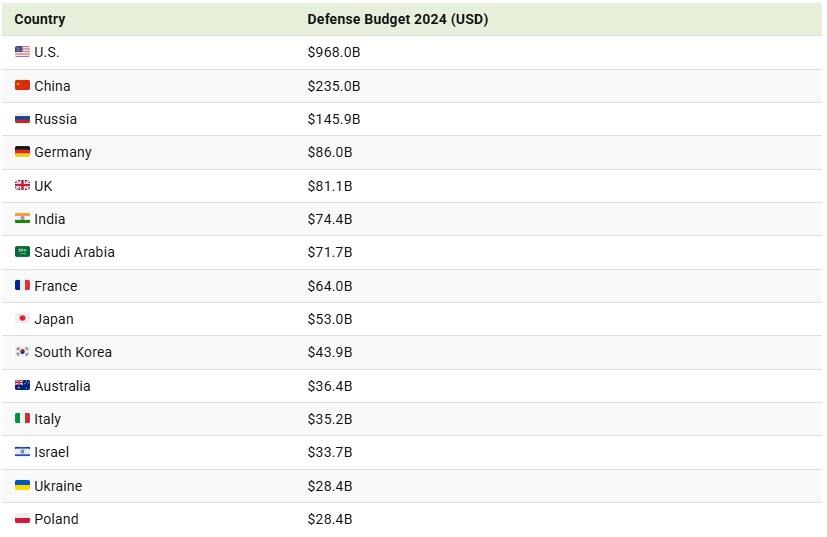(Zero Hedge)—In 2024, the U.S. spent nearly $1 trillion on its defense budget, equal to 3.4% of GDP.
In contrast, NATO members in Europe and Canada spent an average of 2% of GDP on defense. While NATO’s defense budgets have declined since the Cold War, Russia’s military spending has surged by 227% since 2000, and China’s has skyrocketed by 566%.
This graphic, via Visual Capitalist’s Dorothy Neufeld, shows the top 15 largest defense budgets in 2024, based on data from the International Institute of Strategic Studies.
America’s Defense Budget Towers Over the Rest
Here are the largest defense budgets worldwide, illustrating America’s continued dominance of hard power amid unfolding geopolitical conflicts:
U.S. represents OMB adjusted figure. Russia represents National Defense budget plus military R&D funding, military pensions, paramilitary forces’ budgets, and other MoD-related expenses such as housing. Germany includes special fund allocation, military pensions, and military aid to Ukraine. UK includes Armed Forces Pension Scheme and military aid to Ukraine. Poland excludes Armed Forces Support Fund.
As the above table shows, the U.S. spends as much as the next 12 largest defense budgets combined.
Today, just five prime contractors receive 86% of the Pentagon’s spending compared to 51 contractors being allocated 6% of defense spending at the end of the Cold War. Arguably, this concentration has fostered overspending and lower productivity gains.
In an era of all things new, the Trump administration has fired senior leaders in the military, navy, coast guard, and air force. Senior lawyers were abruptly let go too. Overall, the Pentagon could shed 8% of its personnel.
Ranking in second is China, with a $235 billion defense budget. Yet on a purchasing power parity basis, it stands at $477 billion when adjusting for lower costs in China. Overall, the country’s military modernization includes 600 operational nuclear warheads that are projected to reach 1,000 by 2030 as the country increasingly focuses on reunification with Taiwan.
Russia has the third-largest defense budget globally, at $146 billion, representing 6% of the country’s national income—the highest share since the Cold War. Like China, this figure is much higher in real purchasing power terms, rising to $461 billion. Today, Russia’s nuclear arsenal rivals the U.S. with 5,000 warheads, despite being a medium-sized economy.
To learn more about this topic from a U.S. military perspective, check out this graphic on all of America’s military bases worldwide.






Defense budget should be cut in half immediately.
A government strong enough to give you everything you desire, is also strong enough to take away everything you value. We have become vassals of “The MIlitary Industrial Complex”, who will threaten us with every peace of phony hysteria they can muster to keep us allocating more and more and more money for their programs. It is time to stop this madness including shutting down all aspects of the Shadow Government’s Black Special Access Projects.
Apples to oranges comparison. China has better purchasing power (i.e. their tanks, fighter planes, ships, etc. are much cheaper relative to ours) and most of our defense budget is for personnel costs, which are far, far lower for China. Same for Russia.
It would be more meaningful to have them all rated by % of GDP. Raw numbers mean little when trying to ID a threat….like N. Korea.
Ours is too high due to waste and outright THEFT!
Subtract all the fraud, waste, theft, abuse, and incompetence from the U.S. defense budget, and I wonder how large the effective remainder actually is. Maybe the new defense secretary and DOGE can work together to find out.
Raw figures leaves out procurement costs. How about, “the US average resident spends 500% more on eggs than the average Mexican.” If China’s spending has skyrocketed by 566% than it is more like 3 times that when the cost of producing the similar hardware is taken into account.
The cry about how US defense spending (sad that it is needed, while money cannot buy character) is so much more than China and Russia is much that of sophistry, since it ignores procurement costs in addition to other differences.
From 2022:
If you account for differences in reporting structure, purchasing power, and labor costs, you find that China’s 2017 defense budget provided 87 percent of the purchasing power of American’s 2017 defense budget. This runs counter to the conventional wisdom that the United States spends more on its military than the next 12 countries combined or that China lags annual U.S. military spending by close to $400 billion. Those misleading comparisons are based on simply converting Beijing’s reported defense budget from yuan to dollars by applying a market exchange rate. That produces a distorted picture. – https://www.heritage.org/defense/commentary/chinas-defense-spending-larger-it-looks
Even Politio cites research by LTSG, a defense consultancy, that
conducted a multiyear, open-source effort to estimate Chinese defense spending since 2000 by service across different categories such as personnel, operations and maintenance, and procurement…For procurement, U.S. dollar estimates were converted to renminbi. The results showed consistent annual inflation-adjusted growth of roughly 10 percent for the past 20 years..If, as projected, by 2024 the PLA’s annual procurement value exceeds that of the U.S. military, then by about 2030 the United States will no longer boast the world’s most advanced fighting force in total inventory value. – https://www.politico.com/newsletters/politico-china-watcher/2021/05/27/
And besides procurement costs,
The official defense budget does not account for all of China’s military-related activities…
According to SIPRI, China’s military spending far exceeds that of its neighbors and was greater than the combined expenditure of India, Russia, Japan, South Korea, and Taiwan in 2019. Cross-national comparisons are insightful, but accounting for variations in prices is difficult. For example, the current annual pay for an entry-level active-duty U.S. soldier (about $39,600) would likely cover the cost of several PLA soldiers due to price differences. When adjusted for purchasing power parity (PPP), China’s 2019 defense expenditure rises by well over $100 billion. – https://www.csis.org/analysis/understanding-chinas-2021-defense-budget
Lets remember too that the US defense industry is geared to pump massive costs into a bloated government. The other countries can build much more of the same ammunition and weapons as the usa much much cheaper. We may have amazing planes theirs are rapidly gaining and they can produce them much faster and cheaper. Look at Chinas ship building capacity vs the USA as well. These ships are very advanced compared to comparable NATO ships